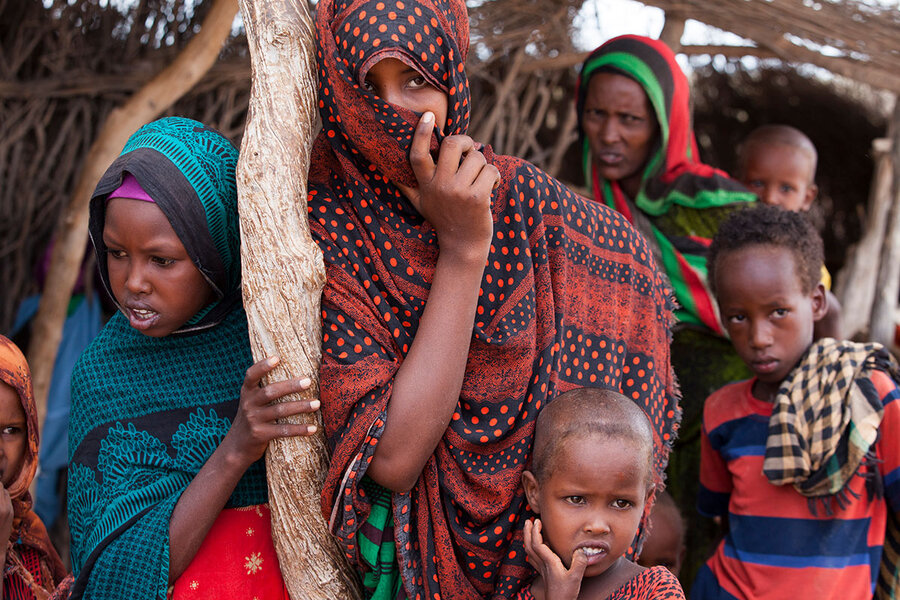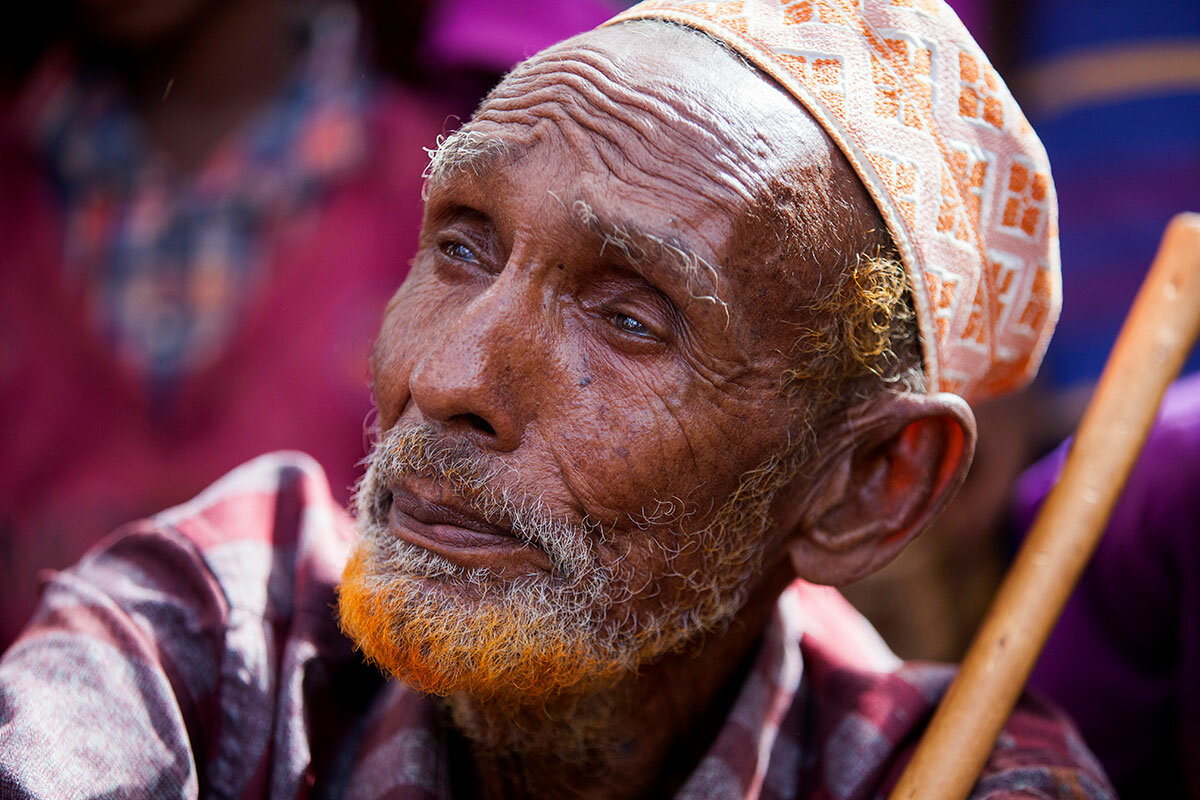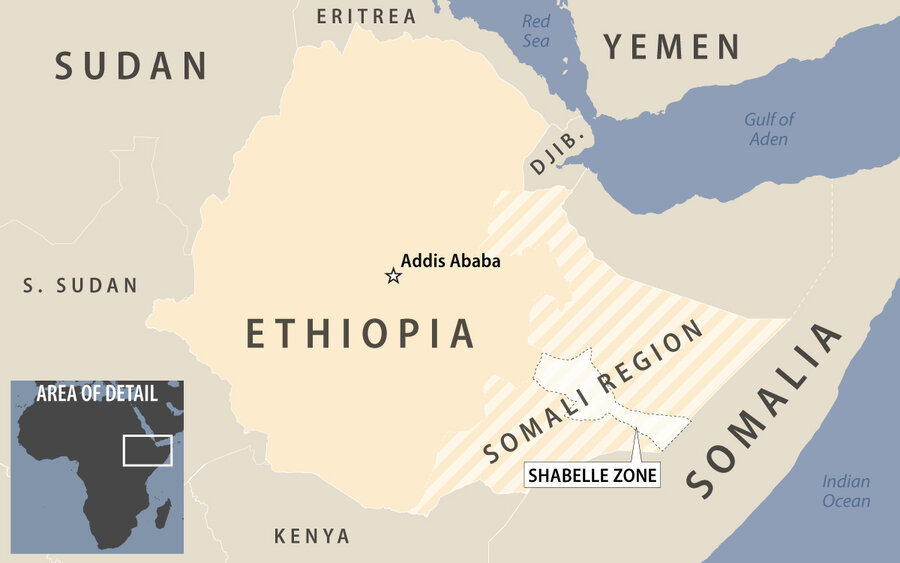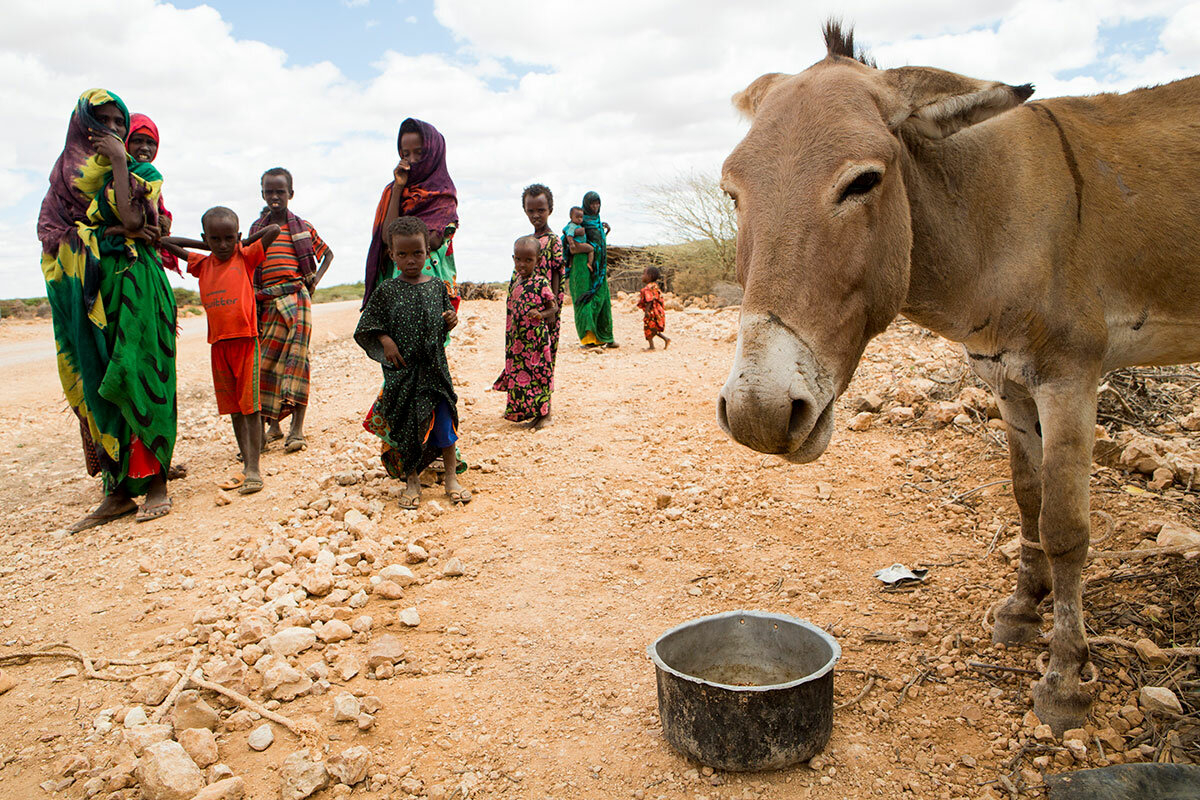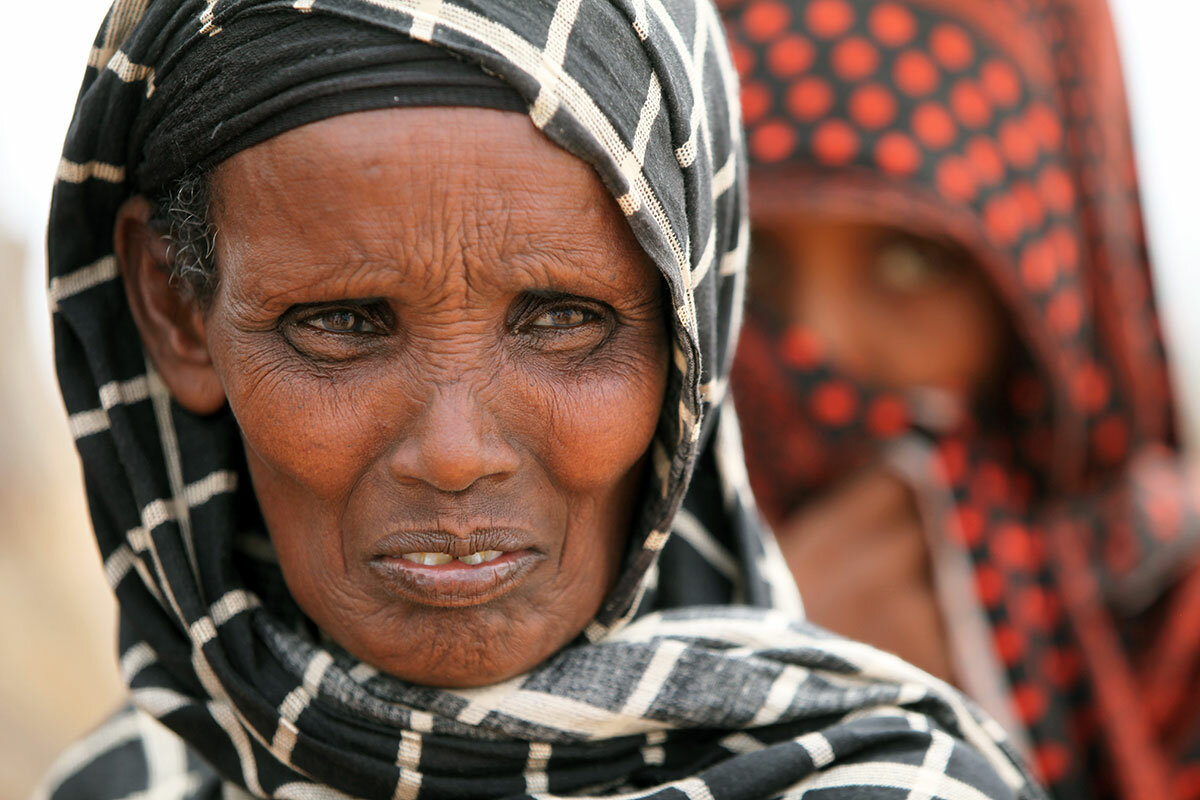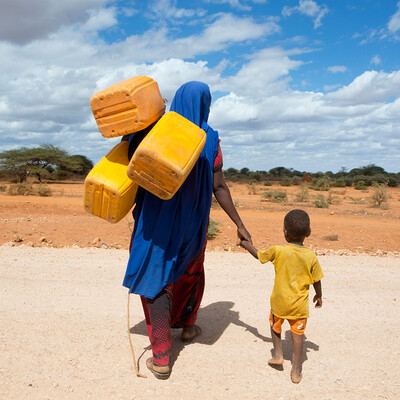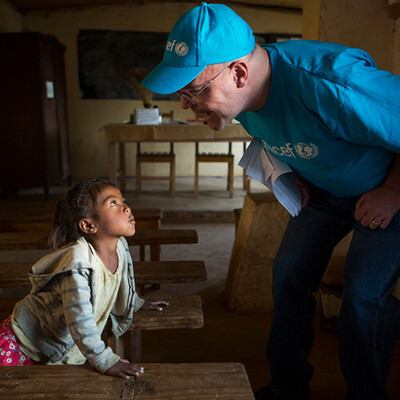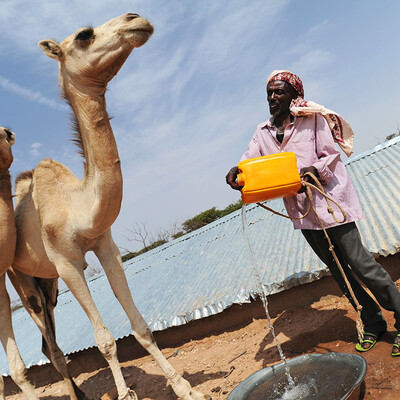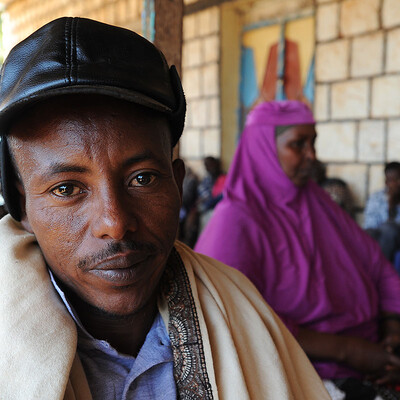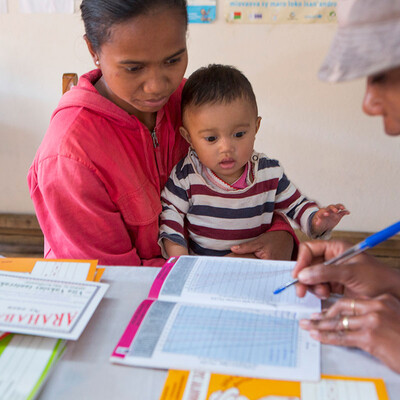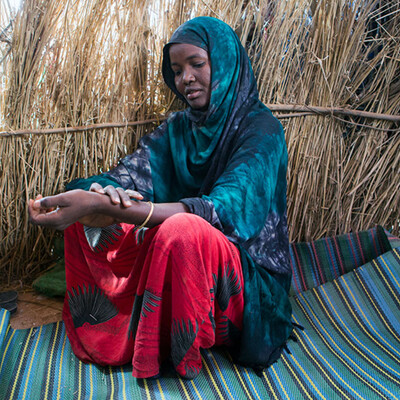In Ethiopia, model drought defenses are put to the test
Loading...
| Gode, Ethiopia
Battered by drought and civil wars, more than 20 million people from Yemen to Tanzania are at risk of starvation in what aid workers call the largest humanitarian crisis since World War II. But over the past two decades, nations that once produced searing images of famine's toll have moved to thwart it by strengthening community resilience. Our reporters traveled to Madagascar, Ethiopia, and Somaliland to investigate the daunting challenges as well as the long-term efforts that are saving lives.
Addis Ababa is hungry. These days, Ethiopia’s capital seems to need more of almost everything: land for factories, shopping malls and highways; steel and concrete to build new skyscrapers; lanky rods of eucalyptus to scaffold their skeletons as they rise. Addis needs more roads, schools, houses, and cars. It needs apartment buildings for its migrants, and five-star hotels for the unending parade of diplomats attending African Union meetings in the glossy new Chinese-bankrolled headquarters at the center of town. The city fills out and up, seemingly insatiable, nibbling into surrounding farmland and poking higher and higher into the smoggy highland sky.
Six hundred miles to the southeast, meanwhile, Ethiopia’s Somali region is hungry, too – or more accurately, it is thirsty. It hasn’t rained here – at least, not enough – in more than a year, and more rain isn’t expected until October. It’s already been long enough that grazing lands have grown huge bald spots, and intake at pediatric malnutrition wards has doubled. It’s long enough that ribs ripple visibly beneath the skin of those few cows and camels that have survived, and long enough to leave thousands of young people stranded in romantic purgatory: engaged, in love, but without the money to pay yarad, the traditional Somali bride price.
Unlike in Addis, where old Soviet Ladas jostle for space with high-end SUVs on traffic-clogged streets, practically the only vehicles on the roads here are ancient, bug-eyed Mercedes cargo trucks carting water and food aid into remote towns. This is the second severe drought to hit the country in three years, and government and humanitarian agencies estimate that nearly 8 million Ethiopians are currently in urgent need of humanitarian assistance – a figure that is expected to grow amid the dry season, which began in July.
“I’m 80 years old and I’m telling you that I have never seen a drought like this before,” says Abdullahi Abdi, a resident of a windswept Somali region village called Melkaselah, resting his orange henna-tinted beard on a walking stick. It has not rained here in 22 days, he says, at a time of year when the rains should come two or three times a week. “All of our livestock are gone.”
For decades, Ethiopia was synonymous in many Westerners’ minds with scenes like this one, the kind splashed across the world’s front pages during the infamous famines of the 1970s and ‘80s and immortalized in pop music by the cringe-worthy “Do They Know It’s Christmas?” (Suffice to say, in one of the world’s oldest Christian societies, they probably did.)
But now, Ethiopia’s image looks a lot more like its capital city: gleaming, cosmopolitan, and boldly aspirational. Although still a nation of farmers, for the past decade, this has been among the world’s fastest growing economies. It has used that brisk development to slash illiteracy, disease, and extreme poverty – though by methods undemocratic and at times aggressively repressive.
And if Ethiopia was once the world’s poster child for drought mismanagement, it is now the regional model for early warning and nimble response. As two of the worst droughts in recorded history have swept across the country, a muscular, government-led reaction has driven back the crisis to mostly manageable levels – even as in neighboring South Sudan and Somalia, the same weather conditions have brought populations to the edge of famine.
“The drought [of 2015-16] was at least as bad as the drought in the mid-1980s,” says Stein Holden, a professor of development and resource economics in the School of Economics and Business at Norwegian University of Life Sciences, referring to the first of the country’s two recent droughts, which ended last year (the second, in the southern Somali region, is still ongoing). “But because the country is much economically stronger and more stable now it’s been able to provide a lot of the aid itself, without outside intervention.”
Improvement – under pressure
In 2016, indeed, the government of Ethiopia funneled more than $700 million of its own money into drought relief efforts – close to half the total global money that went to the relief effort. It has a standing department for managing natural disasters and amasses thick stacks of weather data from satellites, farmers, and forecasters to predict when the weather may turn again.
The 8 million poorest Ethiopians, meanwhile, benefit from an innovative public welfare system that parcels out small amounts of cash or food during the leanest six months of the year in return for labor in local public works projects: building schools and clinics, fixing roads, digging wells.
“We aren’t just given that money – we work for it,” says Bashir Abdi, a herder in the Shabelle Zone of Somali region, jabbing his finger toward a nearby berkad, a shallow concrete pool used to collect rainwater for the village, that he and others here dug as part of their Productive Safety Net Programme (PSNP) work a few years ago. Such projects are part of a vast network of infrastructure – including nearly 25,000 miles of new roads, 500 clinics, and 4,300 school rooms – that the PSNP’s beneficiaries have built since the program began in 2005.
And though families receive an almost vanishingly small sum of cash – as little as $10 per month per person – the program has been responsible for cutting poverty in the country by 2 percent, according to data from the World Bank, which co-finances the project.
“The system Ethiopia has is spectacular,” says Kelly Johnson, a senior social protection specialist with the World Bank who advises the Ethiopian government on the PSNP. “It has reached a point where it is beginning to serve as a model for other programs in Africa and around the world.”
But Ethiopia’s success story is not a simple one. The government keeps a white-knuckled grip on the media and political dissidents, and patrols the boundaries of the country’s glittering new image carefully. Since political protests broke out in the country in late 2015, more than 500 demonstrators have died, tens of thousands have been arrested, and the country has been placed under a draconian “state of emergency” that, among other things, limits freedom of assembly and speech, and bars certain forms of social media. Journalists are routinely detained or arrested and accused of provoking unrest with critical coverage. (On a recent visit, Christian Science Monitor reporters were assigned a minder to observe their coverage of the drought response.)
International aid groups, meanwhile, speak delicately of past “food crises” (never famines) and outbreaks of “acute watery diarrhea” (never cholera, a more serious diagnosis), careful to avoid offending government overseers who could cut off their access to needy communities. Officials at a hospital in the Somali region visited by The Christian Science Monitor, for instance, said they had evidence that an outbreak of cholera had begun in the area – despite the government’s refusal to confirm this.
“[The government] doesn’t always ask for help in time – their early warning systems are good, but the decision-makers don’t always want to listen,” says an aid worker here who asked not to be identified because of his organization’s ties to the government. There is heavy pressure, he says, to keep international eyes off of situations that could tarnish the country’s image.
Deciding whom to help
In other ways, however, the country is the victim of its own success, says Mitiku Kassa, who heads the National Disaster Risk Management Coordination Commission. Unlike other countries in the region facing disasters, “we can find the money and the resources,” he says, “but it means we spend our development budget on humanitarian issues.” Pouring that money into disaster relief, in other words, is akin to taking out a mortgage on the country’s future.
In Ethiopia, indeed, both government and international NGOs have struggled to convince international donors to cut checks for assistance when drought crises in nearby countries like Somalia, South Sudan, Yemen, and Nigeria are far more dire. The government has asked international donors for $948 million, but received only half of that, according to international NGO Save the Children. In May alone, 700,000 Ethiopians needing assistance went without food support for lack of funding.
“Overall, there’s a big stretch on resources in the humanitarian situation globally,” says Charlie Mason, humanitarian director for Save the Children in Ethiopia. (In March, indeed, the UN’s humanitarian chief, Stephen O’Brien, warned that the world was facing the largest humanitarian crisis since the end of World War II).
And despite the obvious wisdom of early intervention and prevention projects like those carried out in Ethiopia, Mr. Mason says, “donors find it difficult to fund something that hasn’t happened yet.”
But Mr. Kassa and Mason both point out that Ethiopia’s track record in preventing famines should be a vote in favor of giving aid to the country – not against it.
“Sure, Ethiopia is much more self-sufficient [than its neighbors],” Mason says. “But the other side of that is that it’s easier to prevent a crisis here – which I think gives the world a moral obligation to do exactly that.”
'Two polar opposite Ethiopias'
Donors may also have another ethical imperative to assist countries like Ethiopia and its neighbors, which, despite their minuscule contributions to global warming, have been among the hardest hit by the world’s changing climate. The southeast’s current drought comes on the heels of another in the north, which in turn came only three years after the 2011-12 drought in the Horn of Africa and ensuing famine in parts of neighboring Somalia. A generation or two ago, such a rapid succession of extreme weather events would have been unthinkable, locals say.
In the Somali region of Ethiopia, ground zero of the current drought, that series has been especially devastating. Most people here are herders, and families spend generations building flocks of cows, sheep, and camels. Losing them is a form of bankruptcy that could take another lifetime to recover from.
“No rain, no water, no pasture, no milk, no food,” says a local herder named Halima Gawsole, ticking off the things she has lost since the rains first failed here a year ago. Now, she and thirty members of her extended family are on the move, their last possessions tethered to their final animal – a weary donkey. Another family member told them the government was delivering water and sacks of grain nearby, and they’ve come to see if it is true. “We’ve lost everything now,” she says.
For the Ethiopian government, the story told by women like Ms. Gawsole sits uncomfortably beside the story they tell about themselves: one exemplified by Addis supermarkets stocked with French cheese, Coco Pops, and 30 kinds of pasta, a rags-to-riches story set to the soundtrack of whirring drills and thudding hammers.
“There are two polar opposite Ethiopias happening side-by-side,” says a young doctor working in a pediatric malnutrition ward in the Somali region, who asked that her name not be used because “everything you say is political these days.”
The doctor, who comes from Addis and speaks the crisp, placeless English of the internationally educated, spends her days straddling both worlds: by day, treating the babies of women her own age who have never been to school or lived in a house with a tin roof; by night, Facetime-ing with her family in the doctors’ quarters.
But it’s clear there’s a little more of her Ethiopia to go around these days. A generation ago, many of the women she sees each day here might never have made it to a clinic at all. Now, they spend their days in clean, warmly lit wards, coaxing their rail-thin babies to eat sachets of fortified peanut butter. Some of the families here are on the government’s welfare and public works program. Others have gotten assistance – food, water, a bit of cash – from the government or NGOs.
It isn’t prosperity, but it isn’t disaster, either. It’s somewhere in the expanse between – a room full of people just about getting by.




